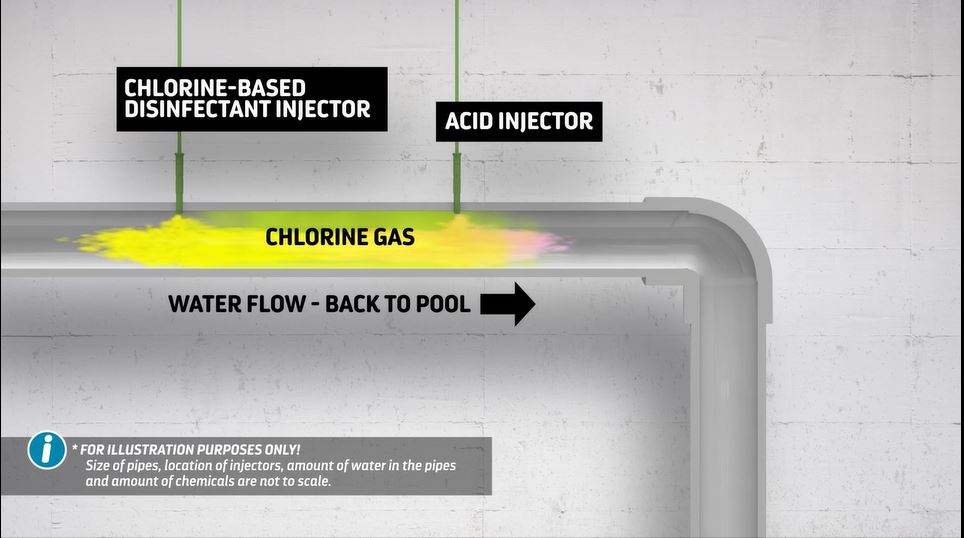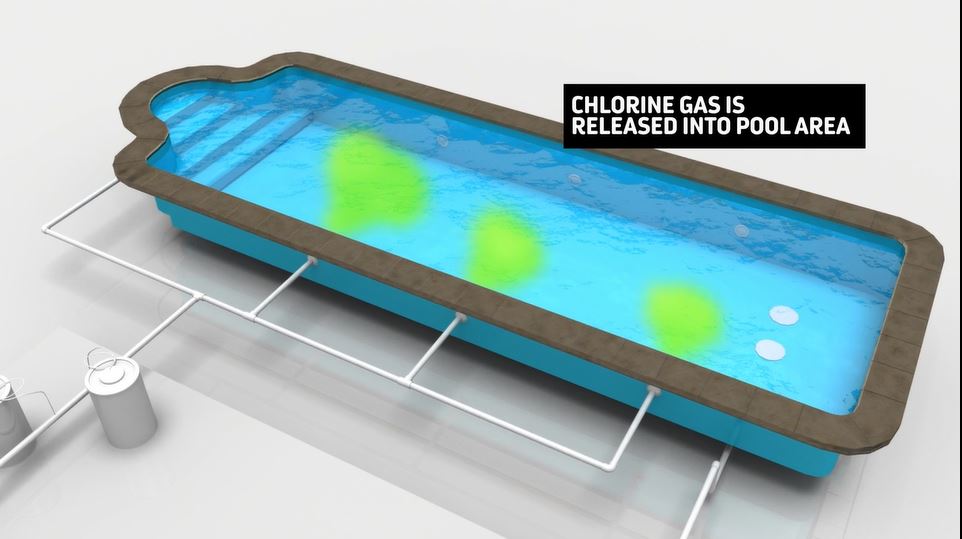Preventing Accidental Bather Exposure
If you were to go into your search engine and type in “Pool Accident Chlorine Gas” in the News tab, you will see nearly 3,000 results populate your screen within seconds. What folks are not realizing is that the overwhelming majority of these incidents were not on swimming pools using chlorine gas. These injuries occurred because of feeder malfunctions on swimming pools that use Liquid Chlorine (sodium hypochlorite), or some other type of chlorine disinfectant.
Headline titles such as “At least 35 people at San Jose swimming pool exposed to dangerous chemical mix“, “19 people hospitalized after pool chemical exposure at Thousand Oaks swim school”, or “8 kids taken to hospital after pool chlorine malfunction in Johns Creek”.

Are accidents like this avoidable? A couple of months back in October of 2018 while at the World Aquatic Health Conference in Charleston, SC, I saw that Kevin Boyer (COO Poolsure) was listed as a presenter. The topic of his discussion was “Exposure to Chlorine Gas – A Report Of Progress by The American Chemistry Council Task Force”. Having known Kevin for years and this, unfortunately, being a regular occurrence in swimming pools throughout the nation, I decided to attend. I am glad that I did. What I found was that, in attending, I was part of the “premiere” audience to what may be one of the most important messages pertaining to safety that would roll out in years.
Six people sent to hospital following super-dosing accident – SPLASH Magazine, Dec 5, 2018
Here is the video that Kevin Boyer and the Task Force assembled by the American Chemistry Council (ACC) had put together:
Following the session, I decided to catch up with Kevin and pick his brain a bit.
Kevin, I have known you for years and you have a long history in aquatics, but I do not think I had ever asked how you ended up in the pool industry. How did you choose this career path?
Like many people, I fell into it and then fell in love with it. I started out with our parent company, Aquasol, and after spending a few years learning the industry I began working with our team to develop Poolsure, our water management and service company.
5 children poisoned by chlorine gas during ‘freak accident’ at swim class – ABC News
You are currently Chief Operating Officer of Poolsure, can you give us a brief overview of what Poolsure is/does?
Poolsure is a service provider to commercial swimming facilities in the SE US. We operate primarily in TX, LA, MS, and FL. We service roughly 7,000 facilities with chemical and equipment service programs.

You were part of a Team assembled by the American Chemistry Council to create a video designed to bring attention to accidental bather exposure to chlorine gas, how big of a problem is this in recreational water venues?
It’s hard to quantify, and I don’t believe anyone is aggregating incidents but it happens very regularly around the world. Just by setting up some simple Google news searches I see at least one or two incidents each week during active pool season. Some of these are manual “mixing” mistakes but many are equipment related. Just one of these accidents is too many when prevention is so simple. It is counter-productive to our mission in the pool industry to have people scared of swimming in a pool.
Florida girl, 4, recuperating after ‘inhaling’ pool water – Fox News
How did you become involved with the ACC on this project?
I saw Tom Lachocki make comments at the 2017 WAHC Conference and mention the ACC Task Group. I had noticed the same trends as NSPF and had, in fact, made a presentation to our management team just a couple weeks before that we needed to help fix this problem. So, when I saw Tom speak, I reached out to him and volunteered to help the ACC Group. It was a great group to work with and I’m very thankful that we were able to produce this video in a relatively short time frame. The whole team did a great job, but Mary Ostrowski who managed the project for ACC, and Andy Johnson from Imed Designs, the videographer, deserve extra special kudos.
Sydney’s Pullman Hotel gas leak: 30 guests treated after pool chemical mix-up – ABC News
I know that there are many contributing factors to protecting bathers from accidental chlorine gas exposure, which would you say is the one area that requires the most attention in order to prevent such incidents?
Education of operators. This is a problem mostly of ignorance. The solution to this problem is truly a no to a low-cost solution. It is my belief that most facilities already have the correct safety switch in place they just inadvertently bypass it in an effort to keep the pool operating during times the circulation system may not be flowing correctly, or the switches aren’t installed correctly, to begin with. If a pool doesn’t have the correct safety switch, in most cases it can be added for less than $200.
Dozens of swimmers sickened by chemicals floating in toxic ‘gas cloud’ over California pool – Daily Mail

I was at the premiere of the video, having attended your presentation at the World Aquatic Health Conference in South Carolina this past October, how was the attendee response to the message?
The response from attendees that I have spoken with since the premiere has been very positive. But, most attendees were already at least somewhat aware of the problem and are just happy to have a documented solution to present. They aren’t the target audience. The goal now is to spread the word to the Pool Operators, Managers, and Service Companies.
More than two dozen hospitalized, released after chlorine gas exposure at Michigan’s Adventure amusement park – Muskegon News
Where do we expect this focus to go from here?
Spread the word. This is a free tool created by ACC for the industry. Please do anything you can to share this video. Use it in CPO classes, other industry training, for company training materials, send it with newsletters, etc. Anything to get the word out. ACC just asks that the video be used in its entirety.
Swimmer sues Brandon L.A. Fitness after chlorine gas mishap in pool – SAINTPETERSBLOG
Similar article: That Chlorine Smell
Please share: This is a super important message that can keep children and other bathers from being put at risk. TYIA





I am against the use of chlorine in swimming pools because it leads to irritation or even severe allergic reactions in many people.
use of chlorine in water treatment plays a very important role. you are correct in noting that it is not perfect, however actual allergic reactions to chlorine are rare. when handled and utilized correctly, risks are minimized and the potential for accidents is greatly reduced.
The bathers’ safety should come first. The treatment of the pools with chlorine must meet all requirements in order to avoid any negative impact on us.
Agreed!
oh wow, very informative article. thanks for sharing
wow I’ve never heard of this before!! very interesting to learn about!
This is the first time that I have heard of Chlorine gas cloud. Thanks for the helpful information.
Great to know. It’s my first time to read about this type of accident. Thank you for sharing.
informative useful sharing, enjoyed my read & appreciate some useful info learnt from here, thanks for sharing this. cheers, siennylovesdrawing.wordpress.com
This was a really informative article, although I don’t frequent the pool anymore, it’s nice to see there are things happening to protect the patrons 🙂
I always have something to learn from you. Not yet started my class as I said before. I have a few questions. Hope to write to you soon. Thanks.
I guess you learn something new everyday. My kids enjoy swimming, I wish there was a place I could take them more.
It’s reasons like this that my husband, who is a biochemist, prefers to do our pool.
I don’t like that chlorine smell at all. It makes me puke. It’s good to have a personal pool for health and other safeties.
Being in a pool is making us vulnerable that’s why it is important the 360 safety of everyone.
Pingback: Preparing Your Pool For a Hurricane - Pool Operator Talk News🗞
Pingback: Pool Rip-offs & Explosions - Pool Operator Talk News🗞